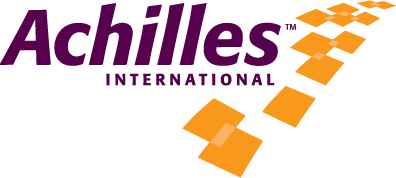
Best Practices for Making Your Race More Accessible
Think about the first race you participated in. Can you remember any details? What was the process and did you feel supported, from registration through the post-finish celebration?
Race organizers are masters at creating moments that move communities of runners. We all want to feel the magic. Making an event that is accessible to people with disabilities is not only the right thing to do, it results in a safer course and a more enjoyable experience for all participants.
Achilles International is here to help. On June 10, 2025, we hosted a webinar with Running USA entitled, “Best Practices for Making Your Race More Accessible.” Below are tips, considerations and tangible strategies to support you as you create a welcoming experience for athletes with disabilities. For more information, contact Kathryn Chu, VP, U.S. Programming at kchu@achillesinternational.org.
Registration
Try to make the registration process as easy as possible for all athletes, including those using assistive technologies or requiring accommodations like guides.
The key for a race director in making athletes with disabilities (AWDs) feel welcome is often as simple as taking the time to ask: “Are you an athlete with a disability?” When a registration form includes that type of question, it begins a conversation to open your race up to more audiences.
Implement a box to check if someone participates in a racing wheelchair, a wheelchair, a handcycle, an adaptive recumbent device, or as a duo.
Ensure forms and webpages are accessible and include imagery of AWDs so they see themselves represented. That can be as simple as adding text to describe the imagery of your social posts as well as Alt Text in the backend.
Provide an opportunity for athletes with disabilities to request guide runners and consider a complimentary guide runner policy.
Create a dedicated page on your website that provides resources for AWDs.
Provide clear email communication on AWD accommodations.
Pre-Race
Consider corrals, start times, announcements, and pre-race accommodations that mindfully incorporate accessibility into the run-of-show.
Incorporate AWD policies and accommodations into staff and volunteer training. Take the opportunity to educate your staff, partners, participants, volunteers and spectators about the different adaptations athletes use to conquer their race. When people know the difference between a racing wheelchair and a handcycle for example, they can celebrate the separate divisions appropriately and participants feel more comfortable knowing who they are.
Communicate the presence of wheelers to all event participants including volunteers. Wheelers could potentially arrive at a particular part of the course sooner than volunteers or staff realize. It is also important that fellow athletes are aware of who they are sharing the course with and how to stay alert while participating.
Communicate course details with AWD participants and guides in advance and at the Start area on race day, especially if there is terrain that may be extra challenging.
Consider how the participants will arrive at the start and depart from the post-finish.
Be mindful of the start area and ensure there are accessible bathrooms and bag check for adaptive equipment needs,
Consider ASL interpreters and sensory zones.
Race Course
Review the guide runner infrastructure, policy and safety for wheeled participants.
Establish a course that is accessible to all participants. Obstacles such as curbs, stairs, speed bumps, uneven terrain, cobblestones, extremely narrow spaces, sharp turns especially coming out of a downhill should be avoided, if possible. If unavoidable, designate an alternate detour for wheelers. If there are areas that can be navigated by a wheeler, but there is a manageable safety concern, set speed rules and mark the course with volunteers with flags or signage.
Consider providing one to three on course mechanics who can assist with a quick-fix for wheeled equipment issues.
Consider assigning a bicycle escort for participants. Some races do this and it works very well.
Consider having flags on the back of equipment, especially for low riding handcycles to be more visible to vehicles and others on the course.
Post-Race
Adjust finisher flows and post-finish reunion area for equipment and caregiver needs.
Consider the start and finish ceremonies from a wheelchair participant’s perspective. Ask, “Are we including all in the event experience? Is it easy to recover bags and equipment? Is there a recovery area?”
Ensure signage is visible and accessible to all participants.
Find ways to integrate AWDs into finisher celebrations, announcements and award ceremonies.
You might not be able to tackle every single thing on this list all at once, and that's okay! Every step and each push, brings another runner to your start line and enriches the experience for all in the community. For example if your signup form is a challenge to update from a resource perspective but remains a critical barrier to participation, can you start by adding contact information for a dedicated person to assist an AWD? Those small steps to adapting have big impacts.
The biggest key to success? When in doubt, consider how you would want to be spoken to, handled, and collaborated with. Everyone just wants to be met with patience and understanding.
Always remember and feel proud that you are part of the inclusion movement!
